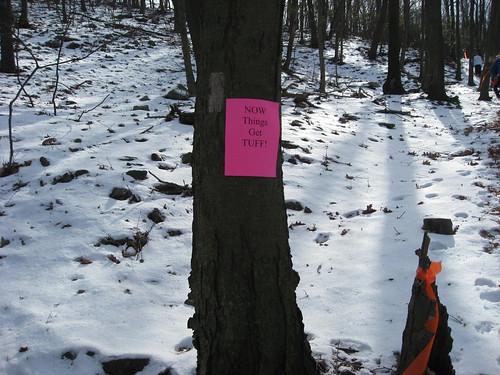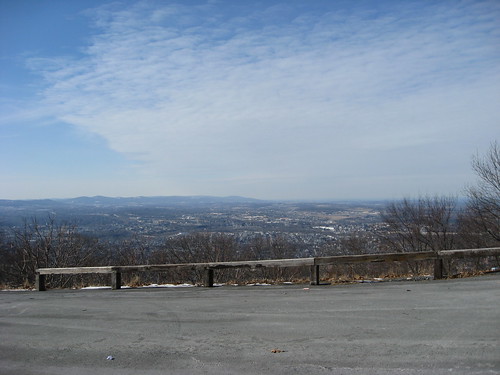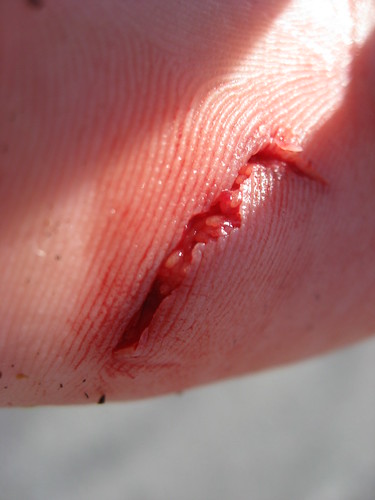2009 Chilly Cheeks Race – Spikes Required
On Sunday Jan. 25, Pretzel City Sports sponsored a race in Reading, PA called the “Chilly Cheeks Trail Run“. Two regular runners from the area, Nate Ribeiro and Bill Yorke suggested the race to twelve people (including myself). It’s a 7.2 mile trail on Mt. Penn. Never willing to back down from a challenge, I signed up. I didn’t expect it would be too difficult, even after numerous warnings from the race director. Here are a few of them:
- “Well, let’s just say that it IS one of the hardest 7.2 Mile runs that most people will ever do.”
- “Sleds for the downhills are ALSO permitted but the installation of an air bag onto them is strongly advised. “
- “Even the federal government won’t be able to “bail out” your quads after this jaunt across the face of Mt Penn overlooking Reading.”
- “The only thing colder than this race is the race director’s heart!”
- “Its downhills are worse than its uphills, as you grab onto every tree in an attempt to save your hide. Rocks, roots and downed logs litter the course, as do the bodies of past years’ DNFs”
I met Bill Yorke and Bill Scannon near their homes, then the three of us piled in Yorke’s car to meet the rest of the troops in Mercer County Park. From there, twelve bold runners left for Reading shortly after 8am. Never having been to Reading before, it became obvious to me as the convoy approached that there would be some serious hills in the race. We made our way to the bib pickup location and finish line, Liederkranz German Singing & Sports Club, a full hour ahead of the 11am start time. The lot and surrounding paths were covered with ice and snow, so much that extreme caution was needed simply walking across the parking lot.
Most people kept inside the Liederkranz to stay warm before the race. I hung around for 20 minutes, but finally decided to do some scouting. I checked out some of the trails near the finish line, found the starting line, and put in about 1.5 miles warming up. There were several runners running around outside, a few of them were in shorts. I actually wore long pants for the race, knowing there would be many thorn bushes to run through.
The race itself was very challenging. After a short jaunt along a flat trail, we made a sharp right uphill turn into the brush. There was no trail to follow, just orange streamers tied to tree branches or bushes every 50 or 100 yards. We all scrambled to climb to the top. Once we arrived, the race officials greeted us and as we ran by, they yelled something about burning leg muscles. I flew by, trying to regain my pace, but quickly encountered another steep incline. After a few more climbs and straightaways, we descended a bit. These descents along ice, snow, loose rocks, logs and tree stumps grew more and more difficult. The remainder of the race was more of the same: steep descents, hard climbs, and a flat trail here or there.
It was difficult to pass people on the climbs because the path was too narrow, but I pushed past where I could. When there was no path, I deviated from the normal trail to pass people here and there, usually breaking through a thorn bush or two, or hurdling over branches or rocks. The race director had posted bright pink signs on many of the trees we passed. There were comical warnings in poetic form about falling on one’s rear. These signs kept us amused. The last sign I remember seeing had a more serious tone, at about mile five “Now Things Get TUFF”:
Once I finished that climb, the course turned into a steep decline about halfway down the mountain. It was hard to maintain control. Below me I saw a sharp turn where we would head back up the mountain. I tried to slow my descent, but at that location there were no trees or branches to grab. I switched my gait and tried to break with my foot, only to fall into a forward tumble. I remember during my fall I was thinking “okay — just get back up and run”. But before I could get back up, my hand was impaled by something very sharp and unforgiving, hidden among the leaves. I caught myself before my face hit the rocks beneath the leaves, but my left hand landed on what felt like a dagger pointing straight up from a tree stump. Without thinking, I stood up and looked at my hand. My glove was still on and there was no hole or tear. However, the throbbing pain called me to peel the glove back and see what had happened. Blood pooled in my palm and I could see my adipose tissue peeking at me. I commented “Wow, that’s deep. That’s really deep.” A runner who approached from behind asked if I was okay. A bit stunned, I didn’t know how to respond so I just said “I guess I’ll see.” I wrapped my glove around the wound and realized there was no one to help me until the finish line. After all, I was on a mountain.
Once I secured the glove to “hold my guts in” and control the bleeding, I started running again. It was a long uphill, but that didn’t phase me. I was more concerned about not using my left hand. Once I reached the summit, there was a spectacular view of the town below.
I snapped a photo with my right hand, then just HAD to look at the wound again, and ultimately decided to snap a close-up of that.
The next half mile was a challenge because I only had one hand to slow my descent on the trails. Finally, I reached a park and recognized it from my earlier scout. I knew I was close to the finish. Elated, I picked up my pace but didn’t know the exact route to the finish. The route led me along one of those initial innocuous trails, but I could see runners ahead struggling to climb (not run or even walk) up a steep hill. I reached the top with the use of only my right hand, albeit a bit slower than I could have if I had both available to me.
At the top of the climb we found ourselves at the rear of the Liederkranz, then had a short sprint around the parking lot until the clock was in sight. But because I wanted to tend to my hand, I didn’t even notice my time on the clock. I stepped out of the chute to ask a race official where to find a first aid kit, but he urged me back into the chute so I wouldn’t lose my place. Too late, a couple people had already passed. I hopped back in the chute where someone tore the ticket from my bib. I searched for a few minutes and found some help. Two EMTs were enjoying some coffee in their cab, but they quickly assisted me.
“Let’s see what it looks like…” one of the EMTs asked, as the other retrieved some saline solution. I gingerly unwrapped the glove from my hand. Surprisingly, the bleeding had stopped but my hand was still covered with dried blood and the lasceration looked deep. “Wow, you’ll need to go to the hospital for two or three stitches. Actually, you’ll probably need more than that.”
They flushed it out, warning me that a wound this deep would burn when cleaned and that the hospital would need to do a more thorough job cleaning it out. Then they wrapped it for me. Fortunately, the cold temperature kept it numb and slowed the bleeding during the race. But as I warmed up, that changed 🙂
Once the remainder of the runners from our group finished, we gathered to share notes on the course, change into drier clothes and warm up. The “Bills” and I left a bit earlier than everyone else though. I decided to wait until I returned to Trenton to visit the emergency room. Since we carpooled, I didn’t want to hold everyone up, or make my wife drive to Reading to pick me up. I ended up getting four stitches and a tetanus shot at Robert Wood Johnson Hospital at Hamilton. Lesson learned: when running a trail run use trail shoes, not normal running shoes. If I had better shoes I may have been able to control my hill descents better and maybe wouldn’t have a hole in my hand now.
My finish time was 1:15:47. I don’t know the names of two of our runners, but here are the results of the other twelve runners. Nice job everyone!
2:05:12 Jennifer Winter
1:55:50 Paul Orihel
1:55:49 Mariana Garcia
1:43:50 Dave Dick
1:36:20 Butch Cuilla
1:36:20 Thomas Peroni
1:35:31 Thomas L Cox
1:29:30 Diana Inverso
1:22:55 Nate Ribeiro
1:22:39 Bill Yorke
1:20:47 Bill Scannon
1:15:47 Frank Sconzo
Chilly Cheeks 2009 – Full Results
I’ll be back to tackle this again next year — spikes or trail running shoes required!


